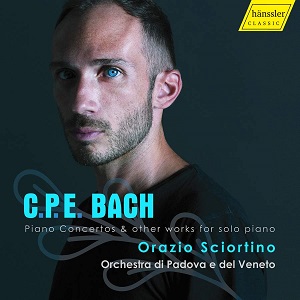
Carl Philipp Emanuel Bach (1714-1788)
Piano Concerto in D major, Wq 43/2, H472 (1772)
Sonatina in D major, Wq 96, H449 (1762)
Piano Concerto in E major, Wq 14, H417
Fantasia II in C major, Wq 61/6
La Gleim, Rondeau Wq 117/19
Orchestra di Padova e del Veneto/Orazio Sciortino (piano)
rec. 2019, Auditorium Pollini, Padova, Italy
Hänssler Classic HC23008 [75]
As much as I like the cello concertos and symphonies of CPE Bach, I have struggled with his keyboard works, be they solo or concerto. I have tried: five years ago, I reviewed another Hänssler Classic release of CPE’s concertos on the piano, concluding that “I would have liked to have been more positive”. Likewise, Danny Driver’s two much-praised volumes of solo works on the piano for Hyperion left me wanting. The same can be said of Haydn’s music in these genres, so it would seem that there is something about the keyboard music between Bach and Mozart that I don’t get.
Now, given this past history, the question that will have occurred to many of you is “why then is he reviewing this recording”. The answer is Víkingur Ólafsson, the Icelandic pianist, whose album Mozart and Contemporaries contained a Rondo by CPE Bach and a sonata by Haydn, both of which I enjoyed greatly. Now I wasn’t expecting to hear Ólafsson‘s extraordinary pianism repeated on this recording, but I did feel that he had opened the door to this music enough that it mightn’t slam shut with someone else at the keyboard.
This new release with Italian pianist Orazio Sciortino would seem to be separate to the existing CPE concerto series on Hänssler Classics with Michael Rische (from which came my earlier review), as there is one work in common (Wq14), and two solo works as well. Yes, two solo works, not three – to my surprise, the Sonatina is for keyboard and orchestra, and a quick check on Wikipedia reveals he wrote more than a dozen such works similarly titled. This one is rather oddly constructed and unwieldy; in two movements, the first – Andante e Arioso – is almost sixteen minutes of slow music, the closing Allegro under three. It almost seems like three separate pieces that have been pushed together, and are not even especially recognisable as by CPE.
However, the two concertos are very enjoyable, with his characteristic relentless and idiosyncratic rhythms dominating the fast movements. At times I did feel a little bombarded by the torrent of notes, and it occurred to me that this together with the percussive nature of the piano might be responsible for my difficulty with CPE’s keyboard music. On the other hand, the slow movements really gripped me, in a way that I hadn’t experienced with the previous disc. The D major Andante is quite exceptional, and has a Mozartian feel to it. The Poco Adagio in the earlier E major work – the date is not given in the booklet, but it is from 1744 – feels more under the influence of JSB.
I’m not convinced that placing the two solo works at the end of the disc was the best way to order them. As far as the music is concerned, it is again the slower one, La Gleim – that appeals more. I can’t tell you what the title means: the booklet doesn’t mention it at all, and Google Translate is stumped. I found that the Fantasia chopped and changed moods too frequently within the five minutes too much to enjoy it.
So did the door stay open? The answer is a qualified yes. There is no doubt that I enjoyed this album considerably more than the earlier Hänssler one, and that must be in most part due to Orazio Sciortino’s excellent performances. I would certainly be interested to hear him play Mozart. Nevertheless, I still don’t think that CPE’s keyboard works will be among my frequently played selections, though I will make an exception for Ólafsson’s and possibly some of the slow pieces.
I’m afraid the notes did very little for me, being very florid in style and overly psychological. Thus we have “voluptuousness of pain”, “metaphysical abysses” and “fibrillating dynamism” among the descriptions. The orchestra is attuned to the changing moods of the music, lean and taut in the fast movements, more sensitive in the slow.
David Barker
Help us financially by purchasing from




















